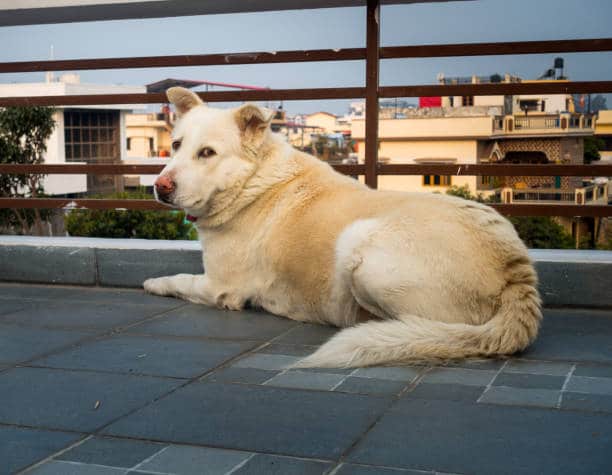If you have a lab and tiling/hardwood flooring, you’ve probably observed that your furry lab struggles to maintain traction on slippery areas. Accidents, slides, and crashes may happen as a consequence of running about the residence. On the internet, there are countless videos pups and eager labs ripping off smooth flooring. When you have a new lab or new floors, you may have to go through a period of uncertainty and do something that will assist your dog traverse your home more easily. Some dogs are afraid of hard flooring and will not step on them. What can you do about your slick surfaces and jittery dog? & Does Your Labrador Hate Tiles Or Hardwood Floors? Here’s Why?
In this article, we will guide you on why your dog, especially lab hates tiles or hardwood floors. We have also come up with the possible soutions. So let’s start.
The Source of the Problem: Why dog hates tiles or hardwood floors?
The feet of labradors designed to dig in the dirt. They, like other dogs, have claws that they utilize for extra stability and support when walking. With each stride, their toes bend and their fingernails stab inside. They can’t dig in with their toenails and obtain a hold on a hard floor, though. One reason your dog might be hesitant to walk on hard floors is because of their paws in general. Longer-haired dogs may have fur that obstructs or covers their feet, making walking more difficult. Longer nails will make it more difficult for your dog to move on rough surfaces.
Finally, labradors suffer from dry skin in the same manner that humans do. Falling is more likely when your dog’s paws are dry and brittle. If your new lab is afraid of your slippery flooring, it’s possible that they haven’t been exposed to a variety of floor surfaces at a young age. This is certainly relevant to dogs that have adopted. It’s possible that if you acquire an adult lab and they act oddly on hard flooring, it’s because they’ve never seen them before. Manhole covers and sewage drains might upset a dog strolling through the town, and hardwood, vinyl, tile, or concrete floors can be unsettling for a dog that has never walked on them.
Hydroplaning on a wet road is similar to sliding on a slick floor.
It reminded me of the horror I had when the SUV I was driving started hydroplaning on a rain-soaked road. I’d lost control of the car, and the systems I relied on to keep me in control—steering and brakes—had let me down.
When the dog’s traction mechanism—flexing his paws and clinging with his nails—doesn’t function, it may be scary for the dog. This is especially true for geriatric and special-needs dogs, who are unable to compensate as well as younger canines.
Senior and special-needs labs are more vulnerable to falling.
I’m not suggesting that sliding isn’t harmful for dogs of all ages, but young dogs are typically able to adjust. They have the stability, muscle power, and muscles and tendons functioning to prevent wiping out if they slip and slide on wooden floors.
For older canines, however, this may not be the case. Our grey-muzzled buddies, like elderly people, often lose their equilibrium, their instincts aren’t as acute, and their muscles shriveled. In their battle against pull, this places these dogs at a disadvantageous position.
In addition, elderly dogs have a harder time getting up from a lying down position. Slipping while climbing exacerbates the situation by several orders of magnitude. When these labs detect that they are falling and attempt to “catch” themselves, they may sustain injuries in the process.
Dogs recall previous sliding incidents.
They too, remember. Dogs recall tumbling or slipping on the hardwood floor as a self-protection strategy. And the dread of tumbling again takes a psychological burden. Fear of slipping as a result of a previous negative experience is often the “why” underlying your dog’s aversion to hardwood floors and other slippery surfaces.
Dealing with rescue lab
If a new rescue dog appears worried or hesitant to go on your flooring, it might because they were disciplined for walking in a certain location, such as the kitchen, and link the floor type with prior adverse reactions. Sliding can also cause injury to older pets. They may be hesitant to walk on sloppy areas because they have already stumbled or lack ability and skills to navigate a slick surface. A nasty fall might result in more than scratches for an older dog or lab with arthritis or other health conditions; certain injuries may necessitate pricey surgery to correct.
Encouraging An Overall Positive Attitude
What can you do to help your frightened lab? If your dog is just terrified of sliding or tumbling on hard floors, there are numerous choices available to assist your dog adjust to the new surface. Dogs with adhesion boots may be ready to surpass their phobia of stepping on a slick surface. Other gadgets that may be stuck to your dog’s pads or fastened to their nails to help them walk more steadily are available. You may also buy traction mats or carpet padding to assist your dog navigate your house. Having to get up from a smooth floor, especially where your dog likes to lay and snooze, can be challenging, especially for older dogs.
Keeping your dog’s nails cut and the hair between their pads clipped will also assist to prevent slippage. If you are unable to cut your dog’s nails yourself, a groomer or even some veterinarians can do it for a small fee. Increased traction will be achieved by placing more of their pads immediately on the floor. Additionally, improving the moisture of your dog’s pads will aid in improving their grip. Natural remedies that help repair dry, damaged paws are available. You may also try to educate your dog to grow familiar with the surface if you have a new dog or new floors. Placing goodies out of reach to entice your dog to investigate should encourage your dog to walk.
4 things you can do if your dog is terrified of hardwood flooring
Discuss any underlying medical issues with your veterinarian
It’s critical to speak with your veterinarian if your dog is afraid of hardwood flooring. A rapid onset of dread of hardwood flooring in young dogs might indicate an underlying physiological or behavioral issue.
Underlying medical issues in senior dogs may be the source of their aversion to rising and walking on wooden floors. Osteoarthritis, thyroid illness, hip dysplasia, and Cushing’s disease are all common disorders in elderly dogs and labs that can make it difficult to navigate slick surfaces.
Maintain your dog’s toenails
When your dog bends his or her toes to acquire traction on hardwood flooring, the extra nail length interferes with the paw’s biomechanics. This reduces your dog’s traction and puts him at danger of slipping and falling. The balance and stride of a dog are badly affected by long nails. It’s wonderful if you have a nail trimming regimen in place.
Keep the hair on your dog’s paw pads clipped
You may check this right now if your dog is sitting next to you while you read this post. Inspect your dog’s paw pads from the bottom up. Do they resemble fuzzy slippers rather than paws? If this is the case, either make an appointment with your groomer or clip the hair around your dog’s paw pads yourself. Maintaining the fur on the bottom of your dog’s paws clipped is a simple and efficient approach to help decrease slippage and enhance grip.
Check to see whether your dog is at a healthy weight
Studies have consistently demonstrated that dogs/labs that maintain a healthy weight live two years longer than their overweight colleagues. They also put less strain on their bones. Obese and overweight dogs, like people, are more inactive and may fail to move, especially on slippery surfaces. Weight control is critical for keeping your dog mobile, which is critical for his long-term health.
Conclusion
You should play your part as a good pet owner to make labs more easy, active, stable and comfortable, whether you have a new lab, new floors, or an aging dog that is scared of tumbling. To ensure that your lab can walk securely in their house, you may either supply rugs or shoes, or purchase area rugs. It is your responsibility to guarantee that your lab regains control while maintaining its fur. Hop you understand that why your labrador hates Hardwood Floors.







